Rachel Neumeier's Blog, page 317
December 30, 2015
Perhaps we should quit calling verbs “weak”
Here’s a nice post from Katherine Kerr, in which she rather firmly suggests that the concept of “strong” verbs versus “weak” verbs is perhaps not terribly helpful and in fact is actually misleading.
English depends on auxiliary verbs like to have, to be, to do, to define many aspects of verbs: tense, duration, possibility, conditionality. It’s impossible to write precise English without using them. … Without auxiliary verbs, it is impossible to use English verbs precisely. That is, if an author was determined to eliminate all auxiliaries from his prose, he could convey simple past and an ambiguously unmarked pure verb form only. Try it and see — absolutely no uses of to be, to have, to do, can, could, would, should, will, shall, and so on allowed. These verbs are a natural and important part of English, as are the participles. They fulfill functions that no other words can fill. .. Only the progressive tense, and the use of “to be” with a participle, conveys the exact meaning of the author. Why anyone would want to throw away such an important tool is beyond me.
Yeah, what she said. Participles and auxiliary verbs are your friends.



December 29, 2015
All the Pretty Horses
So, something else I read recently on my Ilona Andrews kick was “Magic Stars,” a recent novella featuring Derek and Julie. I like both characters and sure, whatever, I am willing to watch the two of them dance around each other with this I-don’t-care kind of attitude. Obviously the reader is in no doubt about a future romance between them, which is fine. Julie’s a little young but given her background, not *too* young.
But that’s not the point of this post. The point is: there’s a moment when Julie rides up on a Gypsy horse and Derek thinks disparaging thoughts about horses in general and Friesians and Gypsy horses in particular and I thought, Wait, what is a Gypsy horse anyway? and pulled out my phone to look up pictures.
Well, Gypsy horses sure are pretty. They are little bitty draft-type horses, some of them just about pony sized, but built hefty, with draft horse conformation, flowing manes and tails, and lots (lots) of feathering on their lower legs. I question the practicality of the feathering, and in fact a minute’s search on the internet reveals that taking care of the legs is indeed a little more complicated for a feathered horse than a non-feathered horse. I’m sure the upkeep must be SO annoying in muddy weather. Still, really pretty. And so many colors! Gyspy horses, also called Gypsy Vanner horses, are meant to be flashy, so in addition to the abundant furnishings, they are bred in all kinds of pinto patterns, plus all the dilute colors, including gray and palomino and also including the far more unusual and extremely handsome silver dilutes. I’m sure you all admire a pretty horse, so take a look at some Gypsy Vanners:
Here is a very flashy, handsome black tobiano Gypsy horse.
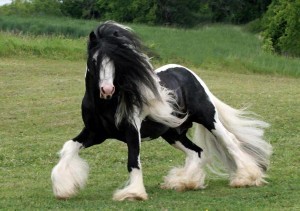
Here we have a pretty buckskin. I actually very much appreciate some of the less flashy horses and I like this one a lot. The furnishings don’t look so extreme, but are enough to add interest. I’d be delighted to ride such a handsome animal.
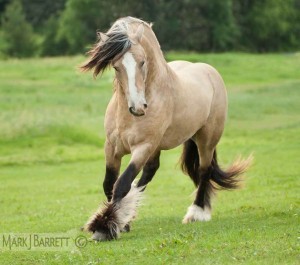
Gold buckskin Gypsy Vanner Horse stallion
And one more: a black silver.
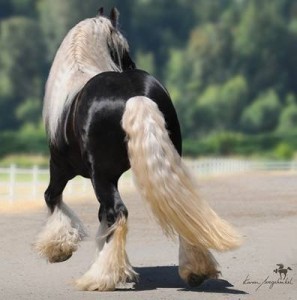
Okay, despite my liking for the buckskin above, I could easily be seduced into preferring this impressive color. This guy must really turn heads.
The silver gene is rare, but you find it in a handful of breeds, notably Rocky Mountain horses, Morgans, Icelandic horses, and evidently also these Gypsy Vanners. The dilute produces a range of effects, but it basically acts on black color, diluting black manes and tails to a much paler color – in this case practically pure white – and also generally diluting the black body color to a dark to medium chocolate shade. On a bay horse, silver dilutes the mane and tail and dilutes the black color on the legs, producing a red silver. On chestnut, the silver dilute is invisible, because there’s no black in the first place.
Aren’t these Gypsy horses lovely? I like the draft horse look, too.
Yes, yes, of course one should select a horse on the basis of structure and temperament first, pretty head second, and color last, but honestly, all these Gypsy horse pictures makes me wish I had time and space and time and money and no back trouble and time, so I could treat myself to a whole herd of beautiful horses.
But! Looking at many, many pictures of pretty horses, lots of them with pinto patterns, makes me want to indulge myself with a quick discourse on pinto patterns in horses. Since I’m sure you’re all also happy to look pretty horses, here goes:
Though many horse people still think of pintos as falling either into the Tobiano or the Overo pattern, this is misleading to the point of doing actual harm. There are actually four main pinto patterns in horses, all controlled by distinct genes that are unlinked to one another, and all dominant to the “wild type” of solid color. Incidentally, trivial white markings such as one white foot or a white snip on the nose are not generally anything to do with pinto genes; they are “extra” and outside this whole discussion.
It’s nice to be able to recognize the four different pinto patterns because a) you get to enjoy your knowledge of color genetics; and b) one of the pinto patterns is lethal in its homozygous form, so if you accidentally breed two of those pintos together, you have a 25% chance of getting a pure white foal that lacks a complete digestive system and starves to death in a couple of days. Speaking as someone who has had, on several occasions, one or more puppies die a few hours or weeks after birth, let me just say that this is liable to be a highly unpleasant event for all concerned and you should totally learn to look at pinto horses properly in order to avoid the possibility.
So, as a public service and also because color genetics is really neat, allow me to present a visual guide to the main pinto patterns:
1. The most common pinto pattern, tobiano. This is a bay tobiano Gypsy horse:
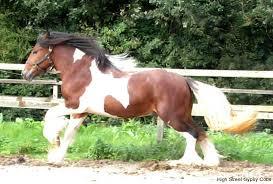
Basically a tobiano horse can be recognized because
a) it has white feet and legs.
b) it has no more white on the head than expected for a solid-colored horse.
c) the eyes are dark, not blue.
d) the markings have smooth, rounded edges and tend to be vertically oriented.
e) the white markings cross the topline in at least one place.
2. The second most common pinto pattern is sabino. Sabino horses can be minimally marked, producing flashy horses that don’t immediately look pinto. People deliberately breed to get minimally marked sabinos — solid horses with lots of “chrome” — in Clydesdales and other breeds. Often a little belly spot will give a minimally marked sabino away, as here:
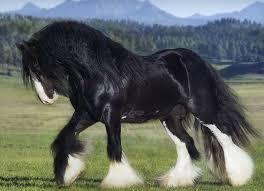
A sabino typically can be recognized because:
a) it has white feet and legs, often with narrow extensions of white extending up from the white stockings.
b) it has a broad white blaze.
c) the white markings often spatter across the body, especially the belly or neck, with heavily “roaned” edges.
d) the white almost never crosses the topline of the horse.
d) the eyes can be brown or blue.
Here is a more extensively marked sabino Gypsy horse:
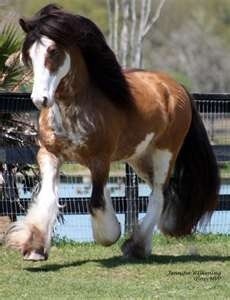
You can also get extreme sabino, which visually intergrades into dominant white. Lots of variation in the sabino pattern. Me, I mostly prefer the minimal sabino types of markings.
3. The third pinto pattern, not as common, is called “splashed white.” I think it really should be called “dipped white.” Visually yourself picking up a sleeping horse with a pair of tongs and dipping it into a vat of white paint. Its head is hanging (that’s why it has to be asleep). This results in:
a) white feet and legs, often white all the way up to the belly.
b) a lot of white patches with clean edges, mostly on the belly and perhaps up the barrel of the horse, but almost never crossing the topline.
c) a very white head, often white all the way up to the ears, with a clean edge between the white and colored portions.
d) typically, blue eyes.
Here is an extreme splashed white horse (not a gypsy, but really *obviously* splashed white):
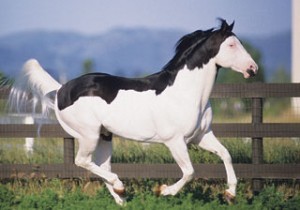
The horse above is completely unmistakable, but a splashed white horse can have much less white on it. Here is a splashed white palomino Icelandic horse:
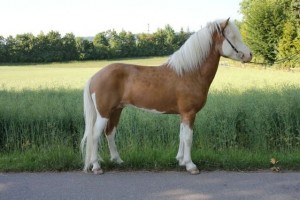
And in fact, if you have a basically solid-colored horse with blue eyes, you might wonder whether it is actually a minimally marked splashed white horse, because blue eyes are so typical with this color.
4. And finally, most important to recognize, the frame pinto or frame overo. This pattern is not all that rare, and this is the one that is lethal in the homozygous form, so if you have a frame pinto, you can assume it is heterozygous. Breeding it to another frame is not a good idea, although breeding it to any other kind of pinto is fine. Frames basically have a dark “frame” around a white “center,” so they look like this:
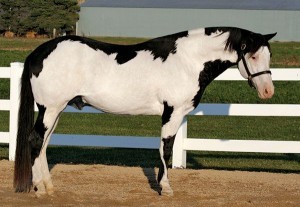
Frames are expected to have:
a) a solid colored topline, dark legs, dark butt.
b) white patches, generally with jagged edges, on the neck and barrel.
c) often a good bit of white on the head.
d) eyes can be brown or blue.
And of course a minimally marked frame pinto might not be this obvious. But this is the basic image you want in your mind when looking at pintos.
Now, the thing to remember about *all* these pinto patterns is that each is controlled by an independent gene, so there’s nothing to stop you from stacking up one pinto pattern on top of another until you come out with a horse that has a whole lot of white on it, but you’re not sure what kind of white. If you’ve resisted the urge to call all non-tobiano horses “overo”, and thus developed your eye for these four different pinto patterns, then you may be able to make a good guess about combo patterns.
For example, I think this horse is probably both tobiano and frame.
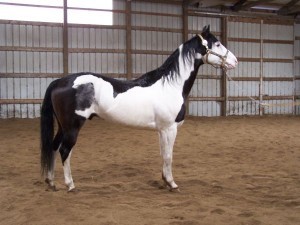
The markings are smooth-edged like a tobiano. The white crosses the topline up on the neck, a typical place to find white on a minimally marked tobiano. White legs are typical of a tobiano but not a frame, so a combination of both would explain the white front legs and dark back legs. If this was my horse and I wanted to breed it, I would steer clear of anything that might be a frame pinto.
This horse might also be both tobiano and frame:
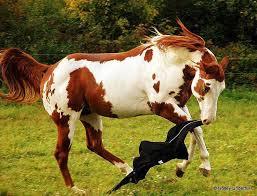
This horse has more jagged edges to its markings, more characteristic of frame than tobiano. It might be sabino plus frame. But either way, it sure looks like frame might be involved.
If you stack up enough different pinto patterns on one horse, you can get a very white animal — a medicine hat, like this:
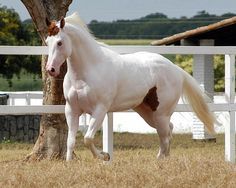
I think it’s safest to assume that a medicine hat horse is a frame plus other patterns unless you are dead sure it is not carrying the frame allele. Which actually, these days, you can check for via a genetic test. But if you are thinking of breeding a medicine hat, then you would want to either do the test or bred it to a very obviously non-frame horse or a solid-colored horse, definitely not anything that could be another frame.
If you happen to write a fantasy novel in which horse breeding is important . . . as in Elizabeth Bear’s RANGE OF GHOSTS, say . . . then it might add an extra bit of authenticity to understand pinto patterns.
Plus, it’s such a good excuse to look at lots of pictures of pretty horses …

December 28, 2015
Stories where nothing big happens
So, as I mentioned yesterday, I can definitely enjoy a story where nothing big is happening, where the salvation of the world doesn’t hinge on the actions of the protagonists, where the issues involved are small scale and low stakes.
I would imagine that these types of stories would be hard to sell to publishers. Lowell’s Solar Clipper novels appear to have been self-published, and Sharon Lee and Steve Miller practically define “niche” with their Liaden novels – they don’t need to “sell” any particular book, I presume; the Liaden series itself has already been “sold.”
What else is there in the ordinary-life low-stakes category? Not much, probably, but every now and then part of a book falls into this category even though there is more of a high-tension plotline in the story as well. I can think of a few examples:
Of the two halves of An Interior Life, I definitely preferred the ordinary daily-life contemporary half to the adventurous fantasy half. Sue isn’t the one saving the world; she has no effect on the protagonists who *are* saving the world, yet somehow her decisions about what color to pain the living room and how to handle her husband’s smarmy boss take over the book.
In the sequel to Cyteen, Regenesis, the part I liked best was Justin and Grant and Ari and everyone getting their lives in order and settling into Ari’s new household. There were some high stakes issues in Regenesis, too – who did kill the first Ariane Emory? Is the world going to fall to a coup? – but first, I didn’t really care who killed the first Ari, and second I assumed that the good guys would win and the coup attempt would fail. But third, really the whole point of the novel, to me, was simply to let everyone, especially Justin and Grant and Ari herself, get their lives in order so that we could have a happily-ever-after type of ending.
In addition to Höst’s Gratuitous Epilogue for the Touchstone trilogy, I would be happy to read another book in Bujold’s Sharing Knife world, just watching Dag and Fawn and everyone live their daily lives. That s right up there with Stories I Would Grab Off the Shelf. A malice outbreak would be fine, but I would expect it to be used to show how the farmers and lakewalkers are more able to work together than in the past; the point of the story would be just show everyone moving into a happily-ever-after future. That would so work for me.
Anyway, in certain kinds of moods, I am plainly a kind of reader that I don’t think publishers realize exists: the kind that enjoys a story in which nothing very striking or climactic happens, in which tension is generally low, in which the pace is primarily slow and day-to-day life takes center stage, in which character development is mainly about characters starting out in a pretty good place and then growing into themselves in a non-dramatic fashion.
This does make me curious: how many of you think or know that you also enjoy that kind of story?

December 27, 2015
Recent Reading: A whole bunch of comfort reads
So, this has been a weird Christmas season for me. Recently I have been seriously distracted. Concentrating on work of my own has been impossible. Usually when I’m starting a new project, or thinking about picking up an interrupted project, I have scenes in my head – I work out the plot and dialogue of many scenes before I start seriously working on a book, often years in advance, and I continue playing around with scenes in my head all during the writing of the book. The hardest part for me is putting in the transitions between scenes I already have in my head, which is sometimes quite tedious; and forcing the development of a new, necessary scene when I get stuck on a plot point, which is less tedious but a lot more difficult.
Anyway, none of that kind of mental work (or play, whatever) has been going on lately. Since early December, my attention has been fixed on other things. I will just go ahead and say at this point that I bred Kenya, that it was an extremely difficult pregnancy (which was expected), that two living puppies were delivered by c-section on the 21st, and that the smaller puppy – markedly less well developed than the larger – died after about 24 hours. The remaining puppy is thriving, and Kenya is doing all right, but working to make that happen has been rather fraught from time to time. Also, what with one thing and another, I will not actually be able to relax about this puppy till he is weaned. If all is well at that point, he will be super cute and I will post pictures.
The one puppy looks okay as far as markings go, which is all I can tell at this age. The markings on his face are quite symmetrical, which is important for a show dog. If he turns out to be as glamorous and well-structured as his parents and especially if he turns out to have the extraordinary vigor and longevity of his grandfather, Kenya’s father, well, it will all have been worth it.
I wasn’t going to explain all that until a happy outcome was clearly guaranteed, but if I’m going to mention from time to time that I’m distracted and stressed, I don’t want people thinking that perhaps I or a close relative or friend has cancer or something else equally horrific. No. The situation with Kenya and her puppy has been and will be stressful, but it’s not like *that.*
But, given the above, I have been reading a whole lot of books in order to get through this stressful period. But if a book is to offer an escape from stress, it has to be the right book; ie, I have wanted comfort reads. For me that means nothing that places significant demands on the reader. Nothing too emotionally intense, nothing where the reader is ever much in doubt about a happy outcome. Nothing too clever or intricate with the worldbuilding. Mostly this means re-reads; or if I’m going to try a new-to-me book, then it means a careful survey of reviews.
Back in early December when I first started doing hours of uterine monitoring every day, I started with:
The Solar Clipper series by Nathan Lowell
I read five of the six Solar Clipper stories. Quarter Share, Half Share, Full Share, Double Share, and Captain’s Share. The one I skipped was the last of the series, Owner’s Share. The reviews of that one made me shy away from it.
I liked these quite a bit as casual, light SF reading. Lowell wrote these, I would say, as kind of SF space opera without the adventure.
What is in these books, you may ask, if not space battles and pirates and aliens and all the other normal accoutrements of space opera? Well, daily shipboard work and making friends and establishing a co-op for small-scale personal trade, transitioning to taking on more authority and working on much larger-scale trade in the later books.
Writing stories that are practically without adventure is nearly but not quite a unique concept. There are a few others out there. Lee & Miller have written a few Liaden books in a similar vein – I mean the Jethri stories, of course. Anyway:
Characterization in the Solar Clipper series I liked the protagonist, Ishmael Wang. I didn’t actually *believe* in him – he is very much a Gary Stu type of character, right down to alllll the women falling in love with him – but I managed to like him despite that. He’s too good to be true, far too socially competent for his age and background, but this didn’t really bother me. I liked the way Ish excels partly because he’s intelligent and a particularly good test-taker, but mostly because he works really hard. Getting ahead because you work hard is way different from being born heir to a prophesy or with special magical powers. I definitely appreciated this aspect of the series. The other characters were generally pretty one dimensional, but I didn’t actually care given my frame of mind. The stories works well for what they are trying to do.
Plotting in the Solar Clipper series: The thing I liked least about the series is how the author would set up some kind of important relationship toward the end of one book, then leap ahead in time, shed the earlier characters (except for Ish), and never bring them back in any substantial way. For example, considering how important Bev and Brill are to Ish in the first few books, they are startlingly absent in the later ones. Oh, the author mentions Bev at the beginning of the 4th book, but casually, just to dismiss her so that Ish can move on.
The writing in the Solar Clipper series: Not in general actually clunky, but not particularly interesting either. I will say, the writing improves over the course of the series. By the 4th book, which is my favorite, the writing is better, particularly the dialogue. Also, there is more of an actual plot in this book. Incidentally, the 4th book would do fine as a standalone if you were inclined to dabble in this world without actually committing to the whole series. Come to think of it, the 5th book also stands alone.
Overall rating: Ratings are hard. Um, three out of five? Five and a half out of ten? Flawed, but quite enjoyable if you are in the mood for this kind of thing. The 4th book, a significant step up from the first three, was probably more like a four out of five, seven out of ten.
Next, I read:
The Across A Jade Sea series by L Shelby. I really enjoyed this trilogy when I first read it, and it held up well for me in re-reading. Then I went on to Shelby’s other series, starting withCantata in Coral and Ivory, but it didn’t work for me. I would say that this one is clever rather than immediately engaging, which is not a bad thing, but not what I needed at the time. So I switched to:
Deeply Odd and Saint Odd by Dean Koontz. I had to re-read the former before I could read the last book in the series. I was positive that Koontz was going to reveal various things in the last book that would tie this series into another of his books, explaining some of the more peculiar aspects of the worldbuilding, but he didn’t. This does mean that he left some important things unexplained. Perhaps this is partly why I liked the last book okay, but not as much as I hoped.
Then I turned to an old favorite: The Touchstone Trilogy by Andrea K Höst, plus the Gratuitous Epilogue. Actually, I read the Epilogue first because it is practically the ultimate comfort read, and then went back and read most of the trilogy, skipping just the first bit and picking up where Cassandra’s talents are first being tested by the Setari.
Unfortunately, I ran out of Touchstone novels. But fortunately I had fallen behind with Ilona Andrews novels, so I read:
Magic Breaks and Magic Shifts by Ilona Andrews. Like the Odd Thomas series, I had to re-read the next-to-last book before I could go on to the actual latest book. These were perfect: engaging, fast pace, lots of action, snappy dialogue. And, not to spoil it, but I never for a moment doubted that Eduardo would be rescued, so that definitely helped make Magic Shifts a suitable comfort read. I’m so pleased the authors are going on with the series because I’m not tired of it at all. I like the direction they’ve taken it.
What I’m reading now: Gunmetal Magic by Ilona Andrews. I’m re-reading this one because a nice familiar world with characters I like and a romance with a happy ending is perfect.
What I will read after this: By the time I’m done re-reading some of Ilona Andrews and picking up some of Andrews’ newer titles like Clean Sweep, maybe I’ll be ready to ease back into my own work. Then maybe I won’t be reading much for a month or two, which would be fine, because really two months of not working on my own stuff is a longish break and I would expect that, as Kenya’s puppy continues to thrive, I will find my enthusiasm for Shadow Twin rekindling.

December 20, 2015
Actually tasty cake houses
A post by Judith Berman at Book View Café, on making edible cake houses.
Production of a Yuletide cake house has become a tradition in my household. I don’t come close to having the skills of a professional baker; these are purely for entertainment (and eating) purposes. gingerbread houseOnce upon a time I made gingerbread houses (one of them is pictured at right), but I couldn’t get people to eat the house at the end of the holiday season. No one hugely loved gingerbread cookies, or the royal icing used for glue and decoration, plus the cookie house got stale. I felt, though, that the point of constructing something out of food was that you eat it.
Tastiness sounds like a definite plus to me. I don’t have many aspirations in this particular area of baking, but I would be happy to admire (and help eat) a house made of pound cake and mud cake. Mm, chocolate. Judith Berman gives a recipe, though I would leave out the bourbon because I can almost always clearly taste alcohol in cake and I always hate it. I might substitute a little more coffee.
Anyway, if elaborate baking is your thing, click through and enjoy the post and the pictures!

First person present tense
Over at Janet Reid’s website, a question about writing in first-person-present. Does it work? Can it sell? Does it turn agents off?
Janet’s answer:
Yes/No/It depends/maybe.
How’s that for a clear answer?
Here’s the real answer: if someone writes back to tell you that present tense doesn’t work in the novel, it’s not about the tense. It’s because the story didn’t grip them enough to forget about syntax, diction, tense and grammar and just KEEP READING!
My colleague Penny Moore and I were talking about this very thing recently. Some really not-well-written books are doing very well because the writer grabs you and doesn’t let go.
Only later, when you’re deconstructing the book (something most regular readers don’t really do!) do you notice plot holes, inconsistencies, and the stuff that makes you wonder what the hell the editor/agent/writer were thinking.
I agree. For me the book that leaps to mind here is DIVERGENT. I found that one a thoroughly gripping read, even though imo it has enormous worldbuilding issues. Even while reading I was like, Really? Are you kidding me? Seriously? But it was a definite page-turner even so.
However, it seems to me that the book that ought to have answered this question is THE HUNGER GAMES. There you go. First person present tense. Did it work? Obviously. Did readers mind the style? Obviously not. Would agents automatically turn down a first-person-present novel on the basis that it is written in that style? Plainly not — or surely not any who are paying attention.
Whether you as a writer are good enough to pull off what is, in my opinion, an intrinsically difficult style is a whole ‘nother question. Just as the early UF writers set a trend for first person, the success of THE HUNGER GAMES no doubt set a trend for first-person-present-tense dystopias. I haven’t read a wide range, but I suspect a whole lot of novice writers who fell in love with THE HUNGER GAMES tried or are trying to write stories in that style, and while that is fine, I expect lots of them will not pull it off. While everyone is different and some writers no doubt fall naturally into a first-person style, I remain convinced that the simplest, most straightforward style for most people is third person past tense limited viewpoint. If you are struggling with a story and can’t seem to pull it off, recasting the first chapters in that simpler style might be a useful exercise.

December 18, 2015
200 years of change for the better
I got the link for this interactive graph from David Brin’s site, Contrary Brin, who says:
A classic animation showing how life expectancy and wealth have varied in a wide sampling of nations, across the last 200 years. See China “bounce” during the 1840s T’ai Ping Rebellion and points scatter during the two world wars, then a more recent acceleration as much of the world catches up – at last – with the West.
It is indeed a pleasure to watch — mostly — though you sure do see points dip and scatter during various disasters. But check it out. It’s hard to remember how terrible life expectancy was 200 years ago. Look at the bottom of the graph and there are all kinds of countries where life expectancy was around twenty-five. Wow.
And can you ever spot the Cultural Revolution. Grim.
Given how times are tough right now all over the world, it’s kind of reassuring to look back to the year 1800 and see how far we really have come, and imagine that whatever happens, hopefully most of the world won’t see more than a slight dip before continuing upward.
For you historians out there: what the heck is going on all through the 1800s that causes India to dip down over and over like a bouncing rubber ball, before it finally starts to climb?

December 17, 2015
Where to start with DWJ
Over at tor.com, a post on where to start with Diana Wynne Jones.
Of course everyone’s always got advice for where a reader might start with the huge backlist of a prolific new-to-them author. However, I admit I disagree with practically all of Alex Brown’s suggestions in this post.
Acknowledging that I am biased toward the first DWJ novels I ever read . . . as I suspect is true for many, if not most, readers . . . I would suggest:
For dog lovers: DOGSBODY, obviously. Not just a dog story, but overall one of DWJ’s finest works.
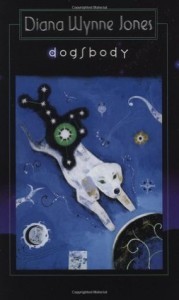
For quiet kids: THE POWER OF THREE. We don’t see enough quiet, introspective young male protagonists. This story offers one of the best — and has good female protagonists as well.
For those who love school stories: YEAR OF THE GRIFFIN, which to my mind stands quite well alone, though I love the prequel as well.
To catch up with pop culture: HOWL’S MOVING CASTLE, both the book and the movie. Now you can get all those references you’ve been missing! Plus, both novel and movie are really good.
Because it will always be one of my favorites: CHARMED LIFE, which I think is my own first-ever DWJ’s novel
My cat is named Chrestomanci, btw.


The Dark Triad
I actually think the Dark Triad probably reflects something more or less real, but I guess I’m okay with having a bit of fun with the concept. So, this quiz, via David Brin on Twitter:
I got “Infrequently vile.” I guess I’ll take that as a compliment…

Dinner with Mr Darcy
I saw this link on Twitter: Dinner with Mr. Darcy, recipes from Jane Austen’s novels and letters.
What a great idea, right?
Mr. Bingley’s white soup, Lady Middleton’s apricot marmalade, Margaret Dods’s pigeon pie, and more literary treats from Georgian England.
I’m all for it. Though I don’t expect to make pigeon pie any time soon. I’m sure one could use chicken instead. However, the recipe given in the post, if you’d care to click through, is for the real thing.
Also, here is a post on Austen’s advice on love, marriage, and how to rebuff a suitor with clarity and kindness.
And now, my dear Fanny, having written so much on one side of the question, I shall turn round and entreat you not to commit yourself farther, and not to think of accepting him unless you really do like him. Anything is to be preferred or endured rather than marrying without affection
Now I kinda want to go re-read something of Austen’s. Not EMMA, which is the only one I didn’t care for. Maybe PERSUASION.




